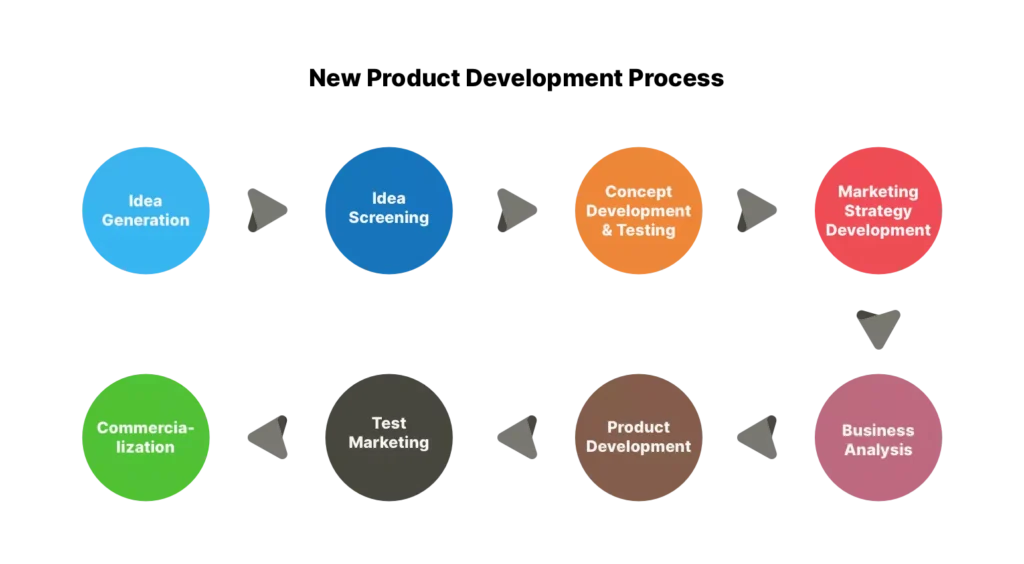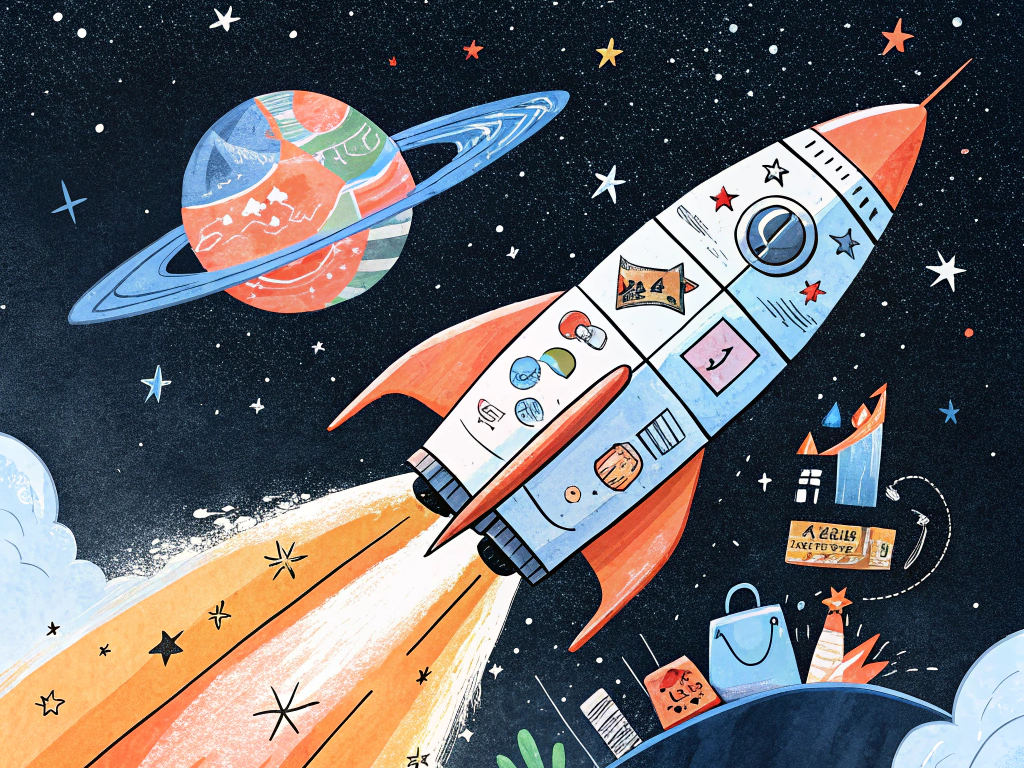In order to stay successful in the face of maturing products, companies need a continuous stream of new ideas successfully developed into new products. The way to obtain new products is to have a structured and carefully executed new product development process (NPD).
But companies face a problem: Although they must develop new products, the odds weigh heavily against success. Among thousands of products entering the process at the top, only a handful eventually reach the market. Therefore, it is of crucial importance to understand consumers, markets, and competitors in order to develop new products that deliver superior value to customers.
In other words, there is no way around a systematic, customer-driven new product development process for finding and growing new products. We will go into the eight major steps in the new product development process.
Oh, and if you want it for takeaway, I’ve got a free eBook that will help you structure your thoughts, avoid mistakes, and properly launch your product and business. It overviews the whole process from the clarity of the idea to the product solution, vision, and investment pitch.
If you’re starting a new business, you could do much worse than to give it a quick read:
Before jumping into the actual new product development process, let’s spend a few seconds on understanding what new product development (NPD) actually is.
As always, there is a number of ways to define NPD. This also depends on the angle you take. From a marketing perspective, new product development refers to the complete process of bringing a new product to the market. This may be a completely new product, but it may also mean renewing an existing product. In some cases, we may also refer to introducing an existing product in a new market, which usually implies to apply at least a few steps of the new product development process.
As you can imagine, the NPD process looks a bit different when looking at it from an engineering perspective. Here, the technical aspects are more emphasized, while the business implications are in the background. This means that new product development is much more focused on the technical design, integration of features, prototyping etc.
In a sound new product development process, both perspectives (i.e., marketing and engineering) are combined to develop a product that satisfies consumer needs (focus of the marketing perspective) in a technically superior way (focus of the engineering perspective).

Before even getting into the nuances of both approaches, you need to understand one thing. The NPD process is done for the customer, not for your own ego. Always make sure that the customers actually need and want your product, don’t create it just because it sounds good.
While the NPD process can run in parallel in both the marketing and the engineering departments, the first step is usually taken in the marketing department. Here, consumer problems and needs are analyzed to generate new product ideas (see step one below). However, this also occasionally happens in the engineering department. Sometimes, engineers stumble upon great technological solutions – whether there is a need in the market for that solution then remains to be seen. As a result, idea generation on the engineering side can, while of course sometimes resulting in great successes, also waste a significant amount of resources. This implies that idea generation in the marketing department tends to be more efficient and allows to focus scarce resources on those ideas for which there is actual demand in the marketplace.
What both of these approaches have in common is the need for a great Product Manager to make sure the NPD process is successful. If your startup is of a smaller scale and you’re basically doing most of the work, then you’ll need these skills.
Here’s a breakdown of what a PM does:
With a common understanding of what NPD actually is, let’s now jump into the 8 steps of the new product development process.

The new product development process starts with idea generation. Idea generation refers to the systematic search for new-product ideas. Typically, a company generates hundreds of ideas, maybe even thousands, to find a handful of good ones in the end.

Two sources of new ideas can be identified:
The next step in the new product development process is idea screening. Idea screening means nothing else than filtering the ideas to pick out good ones. In other words, all ideas generated are screened to spot good ones and drop poor ones as soon as possible.

While the purpose of idea generation was to create a large number of ideas, the purpose of the succeeding stages is to reduce that number of ideas. The reason is that product development costs rise greatly in later stages. Companies cannot afford to take every single idea to the next stages. Therefore, it is necessary to filter and go ahead only with those product ideas that are likely to turn into profitable products. Dropping the poor ideas as soon as possible is, consequently, of crucial importance.
At this early stage, filtering for the potentially profitable ideas can be tricky. A key to success is to initiate the conversation with customers early and look for feedback. For instance, by surveys and focus group interviews, companies can get early insights whether their ideas might meet customer demands in a better way than existing products.
Here are some questions you can ask yourself to see what ideas deserve to move on to the next stage:
At this early stage, filtering for the potentially profitable ideas can be tricky. A key to success is to initiate the conversation with customers early and look for feedback. For instance, by surveys and focus group interviews, companies can get early insights whether their ideas might meet customer demands in a better way than existing products.
To go on in the new product development process, attractive ideas must be developed into a product concept. A product concept is a detailed version of the new-product idea stated in meaningful consumer terms. You should distinguish the following sub-stages:
Concept development and testing is a crucial stage in the new product development process. Therefore, let’s go into the two sub-stages in more detail.
Imagine a car manufacturer that has developed an all-electric car (BEV). The idea has passed the idea screening stage and must now be developed into a concept. The marketer’s task is to develop this new product into a number of alternative product concepts. Then, the company can find out how attractive each concept is to customers and choose the best one.
A product concept should at least capture the realization or form the product will take, the target group it caters to, as well as the main use cases. Possible product concepts for the electric car idea could be:
As you can see, these concepts need to be quite precise in order to be meaningful. In the next sub-stage, each concept is tested.
New product concepts, such as those given above, need to be tested with groups of target consumers. The concepts can be presented to consumers either symbolically or physically. The question is always: does the particular concept have strong consumer appeal? For some concept tests, a word or picture description might be sufficient. However, to increase the reliability of the test, a more concrete and physical presentation of the product concept may be needed. After exposing the concept to the group of target consumers, they will be asked to answer questions in order to find out the consumer appeal and customer value of each concept.
At the end of the concept testing stage, you should have a clear idea of which product concept is the best in terms of customer feedback. In some cases, it may be that several concepts seem to work great. For instance, two different versions may prove to cater well to two different sub-target groups. Provided each of the target groups provides a sufficiently large and relevant target market, the company may choose to go ahead with both product concepts.
The next step in the new product development process is the marketing strategy development. When a promising concept has been developed and tested, it is time to design an initial marketing strategy for the new product based on the product concept for introducing this new product to the market.
The marketing strategy statement consists of three parts and should be formulated carefully:
Once the company has decided upon a product concept and marketing strategy, management can evaluate the business attractiveness of the proposed new product. The fifth step in the new product development process involves a review of the sales, costs and profit projections for the new product to find out whether these factors satisfy the company’s objectives. If they do, the product can be moved on to the product development stage.

In order to estimate sales, the company could for instance look at the sales history of similar products and conduct market surveys. Having a precise view of the likely demand for the eventual product is absolutely crucial. There are countless cases where this stage was underestimated. For example, think of cars that turned out to be flops when introduced to the market. Often, companies tend to skip this stage or spend too little time on it. The reason is in many cases a bias to focus too much on the company perspective, rather than listening to customers. When you come up with a new idea, think it through, design the product, include all those features you like and so on, you may have developed a great product for yourself. However, this does not mean that it will be a great product for the market. Customer feedback is therefore a critical element along all stages of the new product development process.
Once the initial demand analysis has been estimated, the company should be able to estimate minimum and maximum sales to assess the range of risk. Based on the sales forecast, the company should estimate the expected costs and profits for a product, including marketing, R&D, operations etc. All the sales and costs figures together can eventually be used to analyze the new product’s financial attractiveness.
The new product development process goes on with the actual product development. Up to this point, for many new product concepts, there may exist only a word description, a drawing or perhaps a rough prototype. But if the product concept passes the business test, it must be developed into a physical product to ensure that the product idea can be turned into a workable market offering. The problem is, though, that at this stage, R&D and engineering costs cause a huge jump in investment.
The R&D department will develop and test one or more physical versions of the product concept. Developing a successful prototype, however, can take days, weeks, months or even years, depending on the product and prototyping methods.
Also, products often undergo tests to make sure they perform safely and effectively. This can be done by the firm itself or outsourced.
In many cases, marketers involve actual customers in product testing. Consumers can evaluate prototypes and work with pre-release products. Their experiences may be very useful in the product development stage.
The last stage before commercialization is test marketing. In this stage of the new product development process, the product and its proposed marketing program are tested in realistic market settings. Therefore, test marketing gives the marketer experience with marketing the product before going to the great expense of full introduction. In fact, it allows the company to test the product and its entire marketing program, including targeting and positioning strategy, advertising, distributions, packaging etc. before the full investment is made.
The amount of test marketing necessary varies with each new product. Especially when introducing a new product that requires a large investment, when the risks are high, or when the firm is not sure of the product or its marketing program, a significant amount of time may be spend on test marketing.
Test marketing has given management the information needed to make the final decision: Launch or do not launch the new product. The final stage in the new product development process is commercialization. Commercialization means nothing else than introducing a new product into the market. At this point, the highest costs are incurred: the company may need to build or rent a manufacturing facility. Large amounts may be spent on advertising, sales promotion and other marketing efforts in the first year.

Some factors should be considered before the product is commercialized:
Getting the product launch right is a key requirement for the success of your product or service.
A well-structured business launch process is the key to the whole venture’s success.
If the initial launch doesn’t meet expectations, it’s okay to make modifications. You don’t have to get it all right at first. That’s why you need to keep a close eye on the launch and track sales figures, gather client feedback, and analyze user satisfaction all the time.
In all of these steps of the new product development process, the most important focus is on creating superior customer value. Only then, the product can become a success in the market. As you can imagine, only very few products actually get the chance to become a success.
The risks and costs are simply too high to allow every product to pass every stage of the new product development process. Given these risks and costs, it is of crucial importance to get these 8 steps of the new product development process right.

Email subscription is available ONLY TODAY (oh, okay, and tomorrow).
Surely, we respect your inbox! Unsubscription works every day.

We’d love to tailor your experience — which of these best describes you?